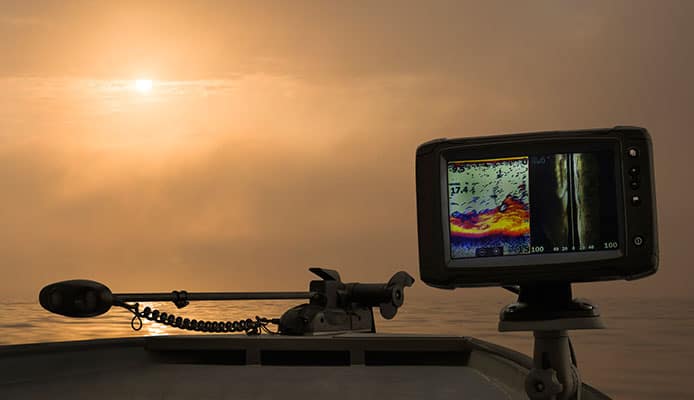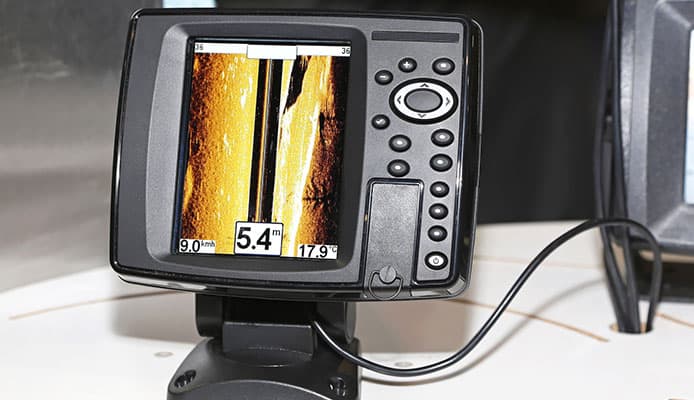
If you love angling, then you must know how important a fish finder is on a fishing trip. It helps you reap the maximum benefits of your expedition and even makes it more enjoyable.
A fish finder will take your fishing to an entirely new level of success whereby, it will change the way you perceive angling, increasing the number of fish that go inside your cooler. However, if not installed right, it can get difficult to use and make the whole exercise a total mess.
There are a few things you should consider when performing your fishfinder installation to make the tool more efficient on-site, but the most important one is to make sure it is placed somewhere accessible and easy to read. In this article, we are going to explain how you can install a fish finder correctly to have a fruitful excursion. Read on!
What Is A Fish Finder?
Just as the name suggests, a fish finder is a device used to detect fish presence in water and measure the depth of the water. It uses the location of an echo to reflect electronic pulses from the fish and other features below the waters and transforms this information into full-color graphics, which are then displayed on a screen for the angler to see.
The displayed image can be in form of a small icon or arc and will enable the angler to know where the fish is and dip their lures and baits into the right depth.
How a fish finder works is that it transmits electrical impulses that are converted into sound waves by a transducer mounted on the transom of the boat. These sound waves are then sent into the water and when they hit something like a fish, they are reflected showing its size, shape, and composition on the screen. The graphical representation will also display how far the angler is from the fish that caused the reflection. How precise and detailed a signal depends on how powerful the pulses transmitted are.
When your boat moves, the fish finder’s screen displays what you can’t see underwater with your naked eyes. You will know when there is fish right underneath your boat, how big the fish is, and exactly where it is, right from the comfort of your deck chair.
A fish finder makes angling easier and is one of the most important pieces of gear that every angler should invest in. If installed properly, you will maximize the enjoyment and efficiency of every rod you cast into the water.
Installing A Fish Finder: Step-by-Step
1. Fish Finder Registration
Even before you prepare your boat for the installation, register your fishfinder. Key in your email and any other registration details requested by the device’s manufacturer.
This will make it easier for you to reach them for help if you have a problem with the setup or whenever issues arise with the system. It also gives the manufacturer a method of contacting you so you can receive constant alerts and updates to make sure your system is always ready to go.
2. Update The Software Of Your Fish Finder
Just like your phone, computer, or any other electronic device requires you to update its software after purchase, a fish finder’s software needs to be updated before use and before installation. And even after setting it up, you will need to be on top of things to make sure the updates are done regularly. Remember this is not something that stays connected to the internet so you won’t be getting any reminders or pop-up messages on new updates, therefore you need to check things out yourself now and then.
Installing software updates for a fish finder is not difficult. Just download the software and save it in a blank memory card, insert the card in the system and turn the power on, and this will give you directions to the rest of your installation. This process will work in most units.
Before installing the updates, however, it would be wise to download and save your GPS coordinates and settings on a memory card and restore the unit to factory settings.
Running the latest version of your system’s software will increase the device’s performance, improve its compatibility, and display the clearest and cleanest images.
3. Get The Right Spot
Decide where on your boat you are going to mount the unit. Make sure the spot you choose is near the helm and is easily visible. Also ensure that it doesn’t affect your movement or interfere with your fishing line, rod, or any other angling equipment you have on board. Mounting the fish finder at the right spot will make it easier for you to use and reduce eyestrain.
4. Find A Power Source
Ensure you have enough power supply to your system and that there is a fuse to protect the system. Also, make sure the wiring of your fish finder or transducer is done far away from the trolling motor wiring to avoid interference.
Several other things can cause interference but if you notice some changes in the image displayed on your screen every time you start the trolling motor, your system needs troubleshooting. You can fix this in several ways but making sure the wiring is done a few feet from the motor is a good place to get started.
5. Install The Transducer
What Is A Transducer?
Most fish finders depend on transduces to send and receive sound signals. In other words, a transducer is the brain of your fish-finding system. It converts an electrical pulse into a sound wave and a sound wave to an electrical pulse. Simply put, it sends sound waves into the water and receives echoes from the water. This enables your fishfinder to read and interpret what is underneath the waters.
You might also like: Perfect Fish Finders
How Does It Work?
To understand how this device works, think of it as a unit with a microphone and a speaker. Just like the speakers in your house, the transducer receives sequences of electrical pulses, often known as transmitting pulses from the fish finder system. The transducer then converts these into sound, which is transmitted through the water in form of pressure waves.
When these waves strike objects in the water, may it be rocks, weeds, fish, or even the bottom of the water body, they bounce back. This is what forms an echo, just like your voice would echo off when talking in an empty room. When the transducer receives the echoed sound, it transforms it into electrical energy, just like a microphone does.
A transducer spends most of its time listening to echoes and the least time transmitting electrical pulses. However, the period spent in pulse transmission and echo listening is measured in milliseconds, so it would be very difficult for an angler to calculate the amount of time between one pulse and another. The transducer helps to calculate this time and displays this information on the screen in a manner that the angler understands.
Transducer Mounting Board
To start the installation, acquire a transducer mounting board first. This will be installed on the boat’s stern using two screws. These could be the best two holes you ever drill in the entire fish finder installation and will save you a lot of trouble in the maintenance of your boat. Installing a mounting board will also give your clear images on the display.
If you ever need to replace your transducer, you can do so directly on the mounting board without drilling more holes on the stern, which in return will lengthen the life of your boat. And if you accidentally hit something and the transducer gets ripped off the transom of your boat, the impact will only affect the mounting board leaving your boat intact.
Installing A Transducer
Honestly, no rule governs how to install a fish finder transducer or where to mount it on your boat, but to get the best performance you must make sure it is located at the right place and the right angle. If you don’t keep location and angle in mind during the setup, there is a high possibility that the images and arches won’t be clear, and what shows on the display won’t be accurate.
Move your transducer to different points until you are satisfied with the angle. Make sure you only use the holes you drill on the mounting board during the relocation. Otherwise, you are going to have more holes on your boat than you can imagine, and slowly by slowly, your expensive boat will start wearing out.
Boats are different and there are many places you can mount your transducer to have a successful expedition. However, based on the popular transducers in the market today that use 2D, side imaging, and down imaging, here are things to consider when deciding your transducer’s location and angle:
- The transducer must be mounted close to the boat’s centerline but not too close to the engine that it gets constant interference from cavitation.
- The location of the transducer must be such that it allows it to see both sides of your vessel clearly without interference from boat anchors, fishing equipment, outdoor motor, or anything else that could get in the way of its operation.
- The transducer must be touching the water all the time. Where this device sits in the water can make a difference between a good and a bad fishing trip. Move the transducer up, down, or sideways until you get a clear image.
When you mount the transducer on the transom, check and understand what is happening behind your boat when it starts moving. But this is risky so you may need to have someone on the helm like a trusted captain to keep things in check.
Take note of places where there is clear, turbulence-free water, as these will allow your transducer to get accurate echoes, which will in return give an excellent performance of your fish finder. Once you have mastered areas with clean water, you can go ahead with your transducer installation.
Globo Surf Overview
It doesn’t matter whether you are preparing yourself for chasing after catfish, crappie fishing, or catching salmon – you will definitely catch more fish with a fish finder. However, ensure your fishfinder installation is done right from the word go, as it is the only way you will have some luck with these water creatures.
Make sure you have registered your unit so you can get alerts on new software updates. Have your software updated before use and most importantly have the transducer installed at the right angle and location. If you have done everything right and can interpret what is displayed on your screen, you will be able to locate and hook more and bigger fish.
Single Fishing Products Reviews:
- Lowrance Elite 7 Chirp
- Humminbird PiranhaMax 197c
- Humminbird Helix 5 Fish Finder & Depth Finder
- Humminbird Helix 9 SI Sonar With Dual Beam GPS
- Lowrance HDS-7 Gen-3 Fish Finder
- Lowrance Hook 5 Fishfinder
- Humminbird Helix 10 Fish Finder
- Lowrance Elite 3x Fish Finder
- Humminbird Piranhamax 197c DI Fish Finder


